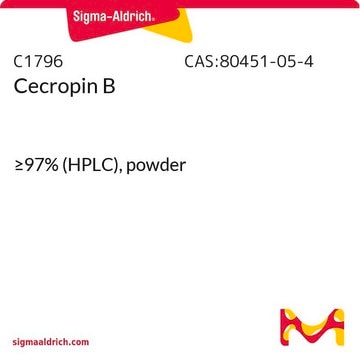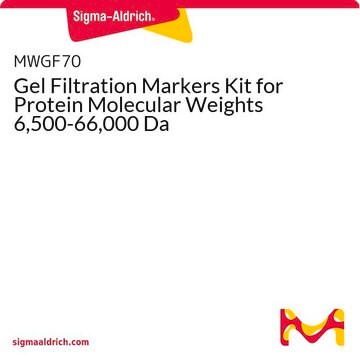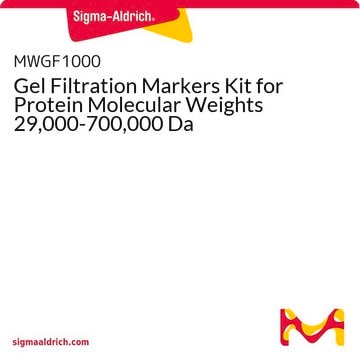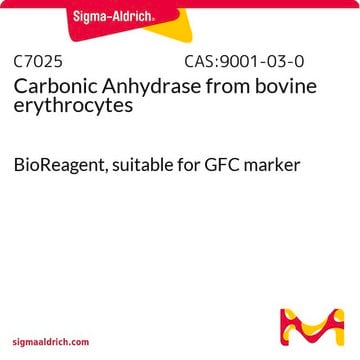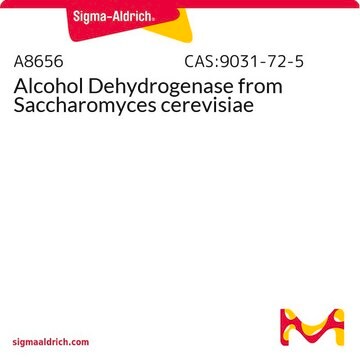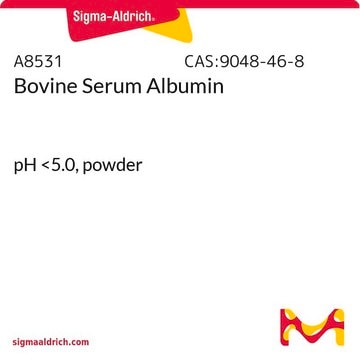C7150
Cytochrome c from equine heart
BioReagent, suitable for GFC marker
Synonym(s):
Cytochrome c from horse heart
Sign Into View Organizational & Contract Pricing
All Photos(1)
About This Item
Recommended Products
product line
BioReagent
Quality Level
form
powder
mol wt
~12,400
packaging
vial of ≥10 mg
suitability
suitable for GFC marker
storage temp.
−20°C
Looking for similar products? Visit Product Comparison Guide
Application
Cytochrome c is primarily known as an electron-carrying mitochondrial protein and is generally regarded as a universal catalyst of respiration. Cytochrome c can be used as a gel filtration molecular weight marker in gel filtration chromatography and protein chromatography and can be used to study cytochrome c control proteins, electron transport and cellular respiration.
The specific sites and extent of oxidation in horse cytochrome c treated with H2O2 and UV were characterized. It was suggested that the state of these sites could be used as a biomarker for the oxidative environment in a cell.
Biochem/physiol Actions
Cytochrome c is primarily known as an electron-carrying mitochondrial protein. The transition of cytochrome c between the ferrous and ferric states within the cell makes it an efficient biological electron-transporter and it plays a vital role in cellular oxidations in both plants and animals. It is generally regarded as a universal catalyst of respiration, forming an essential electron-bridge between the respirable substrates and oxygen
Other Notes
View more information on cytochrome c and electron transport at www.sigma-aldrich.com/enzymeexplorer.
Storage Class Code
11 - Combustible Solids
WGK
WGK 3
Flash Point(F)
Not applicable
Flash Point(C)
Not applicable
Personal Protective Equipment
dust mask type N95 (US), Eyeshields, Gloves
Certificates of Analysis (COA)
Search for Certificates of Analysis (COA) by entering the products Lot/Batch Number. Lot and Batch Numbers can be found on a product’s label following the words ‘Lot’ or ‘Batch’.
Already Own This Product?
Find documentation for the products that you have recently purchased in the Document Library.
Customers Also Viewed
Federica Sinibaldi et al.
Journal of inorganic biochemistry, 105(11), 1365-1372 (2011-09-29)
In cells a portion of cytochrome c (cyt c) (15-20%) is tightly bound to cardiolipin (CL), one of the phospholipids constituting the mitochondrial membrane. The CL-bound protein, which has nonnative tertiary structure, altered heme pocket, and disrupted Fe(III)-M80 axial bond
Paolo Ascenzi et al.
Biochemical and biophysical research communications, 415(3), 463-467 (2011-11-08)
Carboxymethylation of equine heart cytochrome c (cytc) changes its tertiary structure by disrupting the heme-Fe-Met80 distal bond, such that carboxymethylated cytc (CM-cytc) displays myoglobin-like properties. Here, the effect of cardiolipin (CL) on peroxynitrite isomerization by ferric CM-cytc (CM-cytc-Fe(III)) is reported.
Kelly Watters et al.
PLoS pathogens, 14(12), e1007477-e1007477 (2018-12-12)
Viruses in the rhinovirus C species (RV-C) are more likely to cause severe wheezing illnesses and asthma exacerbations in children than related isolates of the RV-A or RV-B. The RV-C capsid is structurally distinct from other rhinoviruses and does not
Gongquan Li et al.
Biochemical and biophysical research communications, 434(4), 809-814 (2013-04-25)
Small-molecule Bcl-2/Bcl-xL inhibitor Navitoclax represents a promising cancer therapeutic since preclinical and clinical studies with Navitoclax have demonstrated strong anticancer activity in several types of cancers. However, because Navitoclax has a low binding affinity to Mcl-1, anticancer activity by Navitoclax
Shuvasree SenGupta et al.
Frontiers in immunology, 12, 659996-659996 (2021-04-30)
Tumor associated neutrophils (TANs) are frequently detected in triple-negative breast cancer (TNBC). Recent studies also reveal the importance of neutrophils in promoting tumor progression and metastasis during breast cancer. However, the mechanisms regulating neutrophil trafficking to breast tumors are less
Chromatograms
application for HPLCapplication for HPLCapplication for HPLCOur team of scientists has experience in all areas of research including Life Science, Material Science, Chemical Synthesis, Chromatography, Analytical and many others.
Contact Technical Service